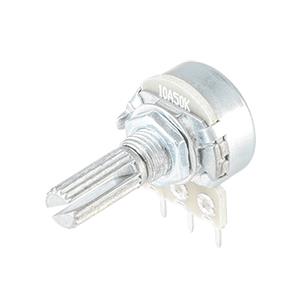
CUI Devices
CUI Devices is a leading manufacturer of electronic components, specializing in a diverse range of products such as connectors, sensors, and power supplies. With a global presence, the company is known for its high-quality, reliable components that cater to various industries including consumer electronics, telecommunications, and industrial applications. CUI Devices is committed to innovation and customer satisfaction, offering a wide selection of standard and custom solutions to meet the evolving needs of the market. Through a combination of cutting-edge technology and exceptional customer service, CUI Devices continues to be a trusted partner for businesses seeking top-notch electronic components.
Rotary Potentiometers, Rheostats
Results:
209
Series
Resistance (Ohms)
Actuator Length
Actuator Type
Bushing Thread
Termination Style
Built in Switch
Mounting Type
Rotation
Power (Watts)
Taper
Adjustment Type
Number of Gangs
Actuator Diameter
Tolerance
Number of Turns
Temperature Coefficient
Resistive Material
Features
Results remaining:209
Applied Filters:
CUI Devices
About Rotary Potentiometers, Rheostats
A rotary potentiometer (pot) is a three-terminal device that utilizes a resistive element and a rotating contact to form an adjustable voltage divider. The resistive element is typically composed of a carbon film or metal wire, while the rotating contact is a metal wiper that moves along the resistive element's surface. By rotating the shaft connected to the wiper, users can adjust the position of the contact on the resistive element, thereby altering the output voltage according to their requirements. If only two terminals are used, connecting one end of the element with the adjustable contact, the potentiometer functions as a variable resistor or rheostat, allowing users to control the flow of current. When selecting a potentiometer, several factors must be considered. These include the resistance value of the resistive element, the degree of rotation/number of turns required for adjustment, the type of taper (linear or logarithmic), the power dissipation capability, the presence of ganged elements (multiple pots controlled simultaneously), the resistive material used, and the termination style for easy integration into the circuitry. Furthermore, some potentiometers come with built-in switch contacts, providing additional functionality for circuit control. The resistance value of the resistive element may range from a few ohms to several megaohms, depending on the specific application and requirements. The degree of rotation or number of turns required for adjustment varies based on the potentiometer's design and intended use. The type of taper used can be linear, where the resistance changes evenly throughout the rotation, or logarithmic, where the resistance varies exponentially. Power dissipation capabilities typically range from 0.1 watts to several watts, with higher power ratings allowing for greater control over high-current applications. Potentiometers can also be configured with ganged elements, where multiple pots are controlled simultaneously using a single adjustment knob or control. The resistive material used in potentiometers can vary, with carbon film and metal wire being the most common. Finally, termination styles may include through-hole, surface mount, or wire leads, depending on the user's preference and circuit requirements. Overall, potentiometers offer a versatile solution for various applications where precise voltage or current control is required. Their selection parameters allow users to choose the right potentiometer based on specific requirements such as resistance range, mechanical specifications, and electrical characteristics. With their adjustable nature and different configurations, potentiometers provide users with enhanced control and customization options for their electronic circuits.


